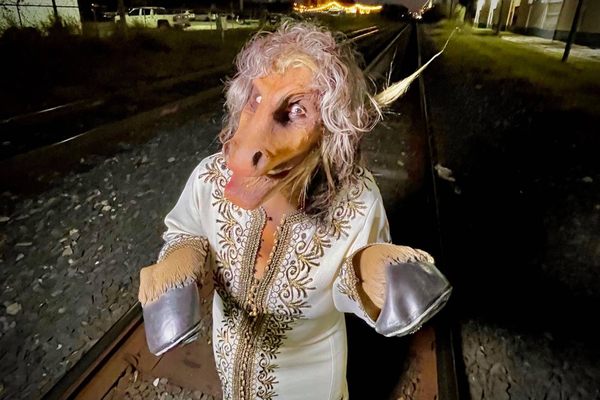The Time a Town Was in an Uproar Over a 300-Foot Ghost Statue
Cast your votes on the “nightmare Statue of Liberty.”
One rainy day in January 2017, a small but determined group gathered outside the parliament building of Pontianak city, Indonesia for a protest. Printed across a large banner was the group’s name: GEMA TOPAN, which (translated from Indonesian) stands for “Community Movement to Reject Ghost Statue.” Along the bottom was the hashtag #tolakpatongantu, meaning “Reject Ghost Statue.”
It was an unusual cause for a demonstration, but these were unusual circumstances. Not long before, word had circulated around social media and mainstream local news that a government official was proposing to erect a sculpture of a bloodthirsty ghost known as kuntilanak. The storm of online outrage from Pontianak locals following this news had motivated the members of the Community Movement to Reject Ghost Statue to organize.
On the other side of this uproar was a man named Kartius, head of the Youth, Tourism and Sports Agency in West Kalimantan. Kartius proposed the idea to build the statue, arguing that the monument would increase tourism. Towering over 300 feet, the ghost would dwarf the buildings around it.
“I have to admit, when I first heard the idea, I laughed out loud,” says Severianus Endi, a journalist who lives in Pontianak and reported on the events as they unfolded. “The ghost of the kuntilanak is a story that we get told in childhood—it’s a tale that parents use to scare their kids, so they don’t go into the forest alone.”

The kuntilanak, also called a pontianak, is envisioned as a “woman with long and dishevelled hair and terrifying face, wearing a long, shabby white dress,” Severianus describes. Versions of her myth exist across Indonesia, Malaysia, and Singapore. In some, she is the ghost of a woman who died in childbirth or carries her dead baby in her womb. She allegedly takes revenge on bystanders by eviscerating them with her long claw-like nails and razor-sharp teeth.
The city of Pontianak was actually named after this ghost. The city, which lies in the West Kalimantan region of Indonesian Borneo, was built in 1771 by The Sultan Syarif Abdurrahman Alkadrie. “It is said that workers who cleared the forest to build his palace were harried by the ghost of kuntilanak,” says Severianus. The Sultan, not willing to let this troublesome spirit hinder his plans, ordered that cannons be fired to scare her off and named the city after her. An annual festival is still held in Pontianak during which meriam karbit, special carbide cannons made from wooden logs, are fired to ring in the end of Ramadan—and make sure the malevolent ghost stays firmly away.
Kartius suggested a monument to this evicted spirit would celebrate the cultural heritage of Pontianak city. The sculpture would follow in the footsteps of the merlion statue in Singapore or the cat statues in Kuching, Malaysia. Given that Pontianak’s tourist attractions were getting rather dilapidated, long queues of tourists paying to climb the tower would provide a much-needed influx of cash. The enormous ghost wouldn’t only be a photo opportunity, Kartius suggested, it could overlook a nice, relaxing recreation centre.

Locals were not pleased by the idea. Pontianak residents pointed out on social media that being able to see the monster of childhood nightmares quite literally everywhere you went in the city didn’t seem appealing. A poll showed 98% of residents were opposed to the idea.
Others, like Severianus, took a more humorous approach. Designs for the statue were posted on social media showing it leering over the city like some nightmare Statue of Liberty. The Mayor of Pontianak, Sutarmidji, said he was intrigued to see what Kartius’s kuntilanak would look like. ‘“I have never met the kuntilanak ghost,” Sutarmidji said in a post on Facebook. “Who will be the model?” People even wondered whether the ghost herself might get displeased and wreak havoc, as discussed in Indonesian newspapers for weeks.
After all this kerfuffle, GEMA TOPAN’s demonstration ended with an anticlimax. They were invited into the parliament building by the staff, who were not quite sure why they were protesting—the statue plans had never been discussed officially. It turned out that Kartius might not have been entirely serious, and the idea had been blown out of proportion in the media. “From my experiences with Kartius, he has quite a sense of humour,” says Severianus. “He likes to say things that will get a reaction.” Kartius retired in 2018, and efforts to reach him for further comment were unsuccessful.
To finally put a stop to the fuss, Mayor Sutarmidj gave a definitive statement in February 2017 that the statue would certainly not be built on his watch; anyone interested would have to find somewhere else to build their ghost.






















Follow us on Twitter to get the latest on the world's hidden wonders.
Like us on Facebook to get the latest on the world's hidden wonders.
Follow us on Twitter Like us on Facebook